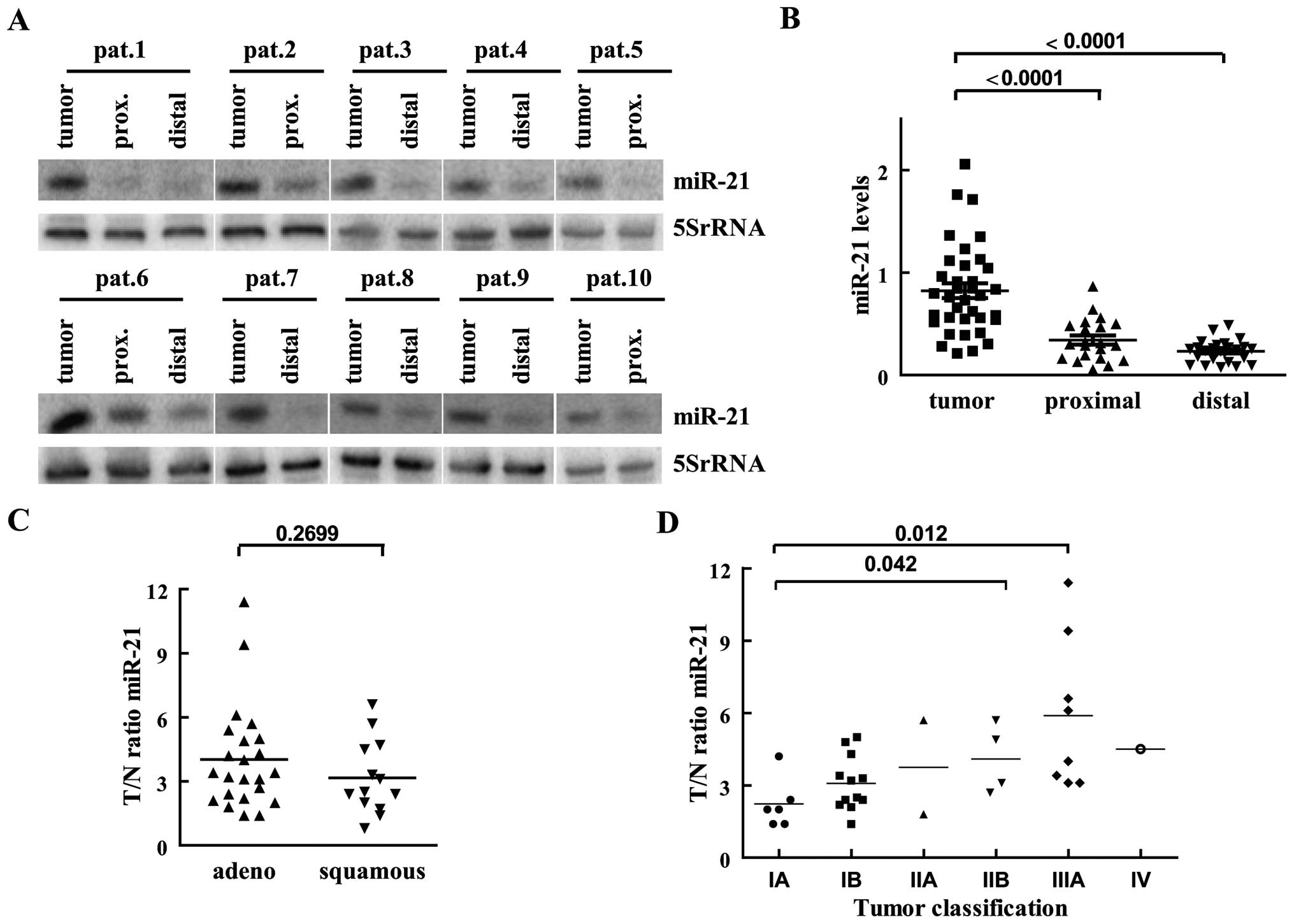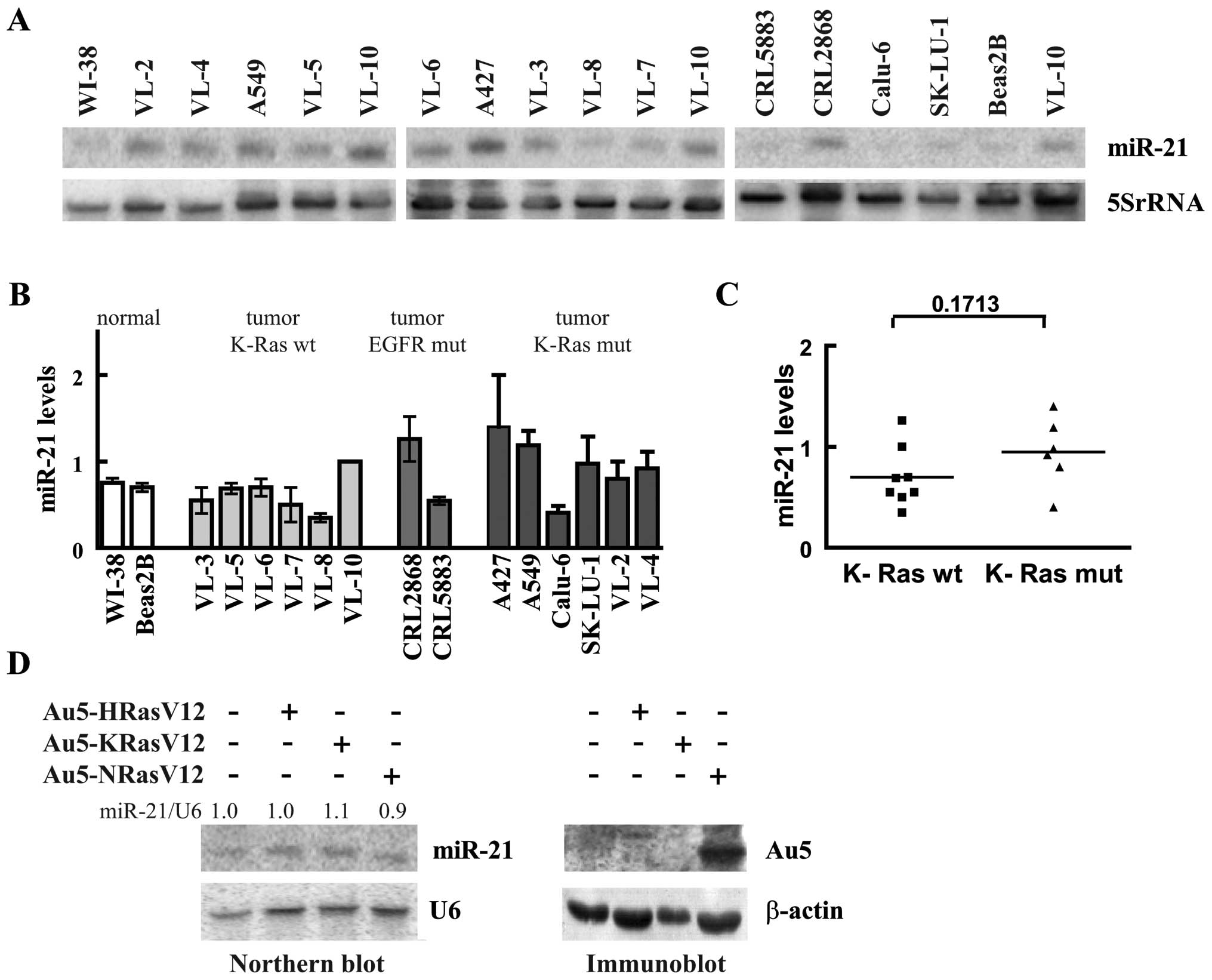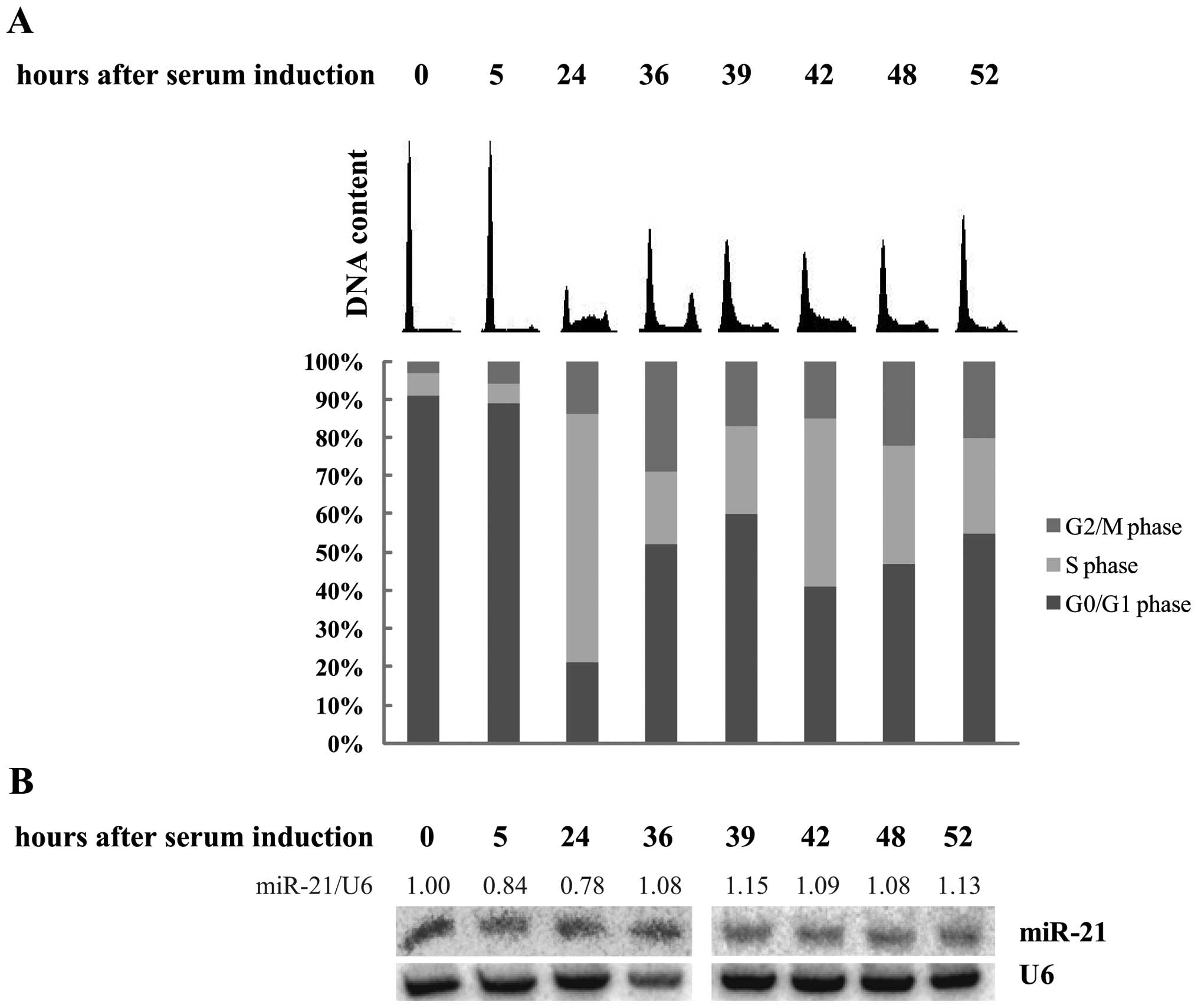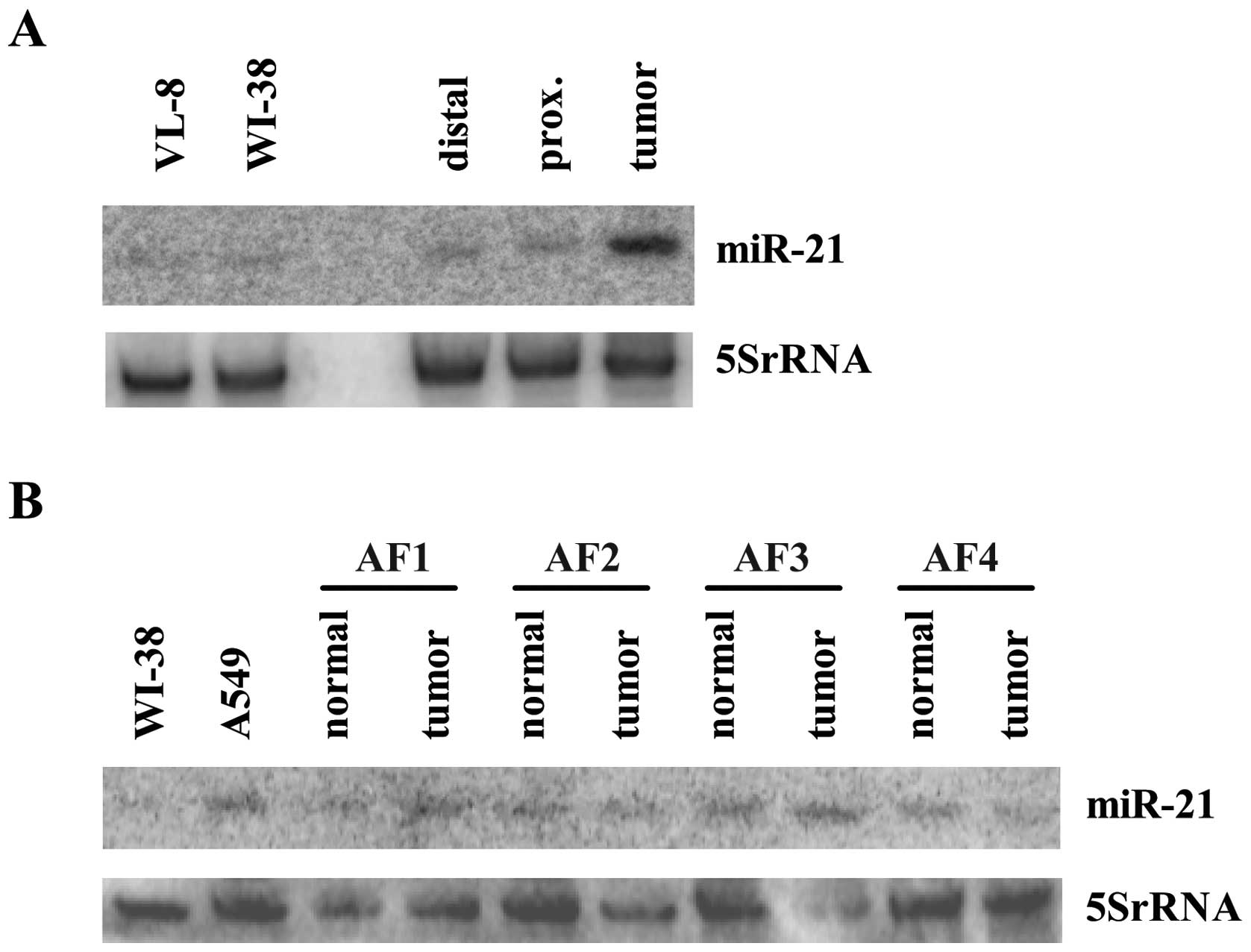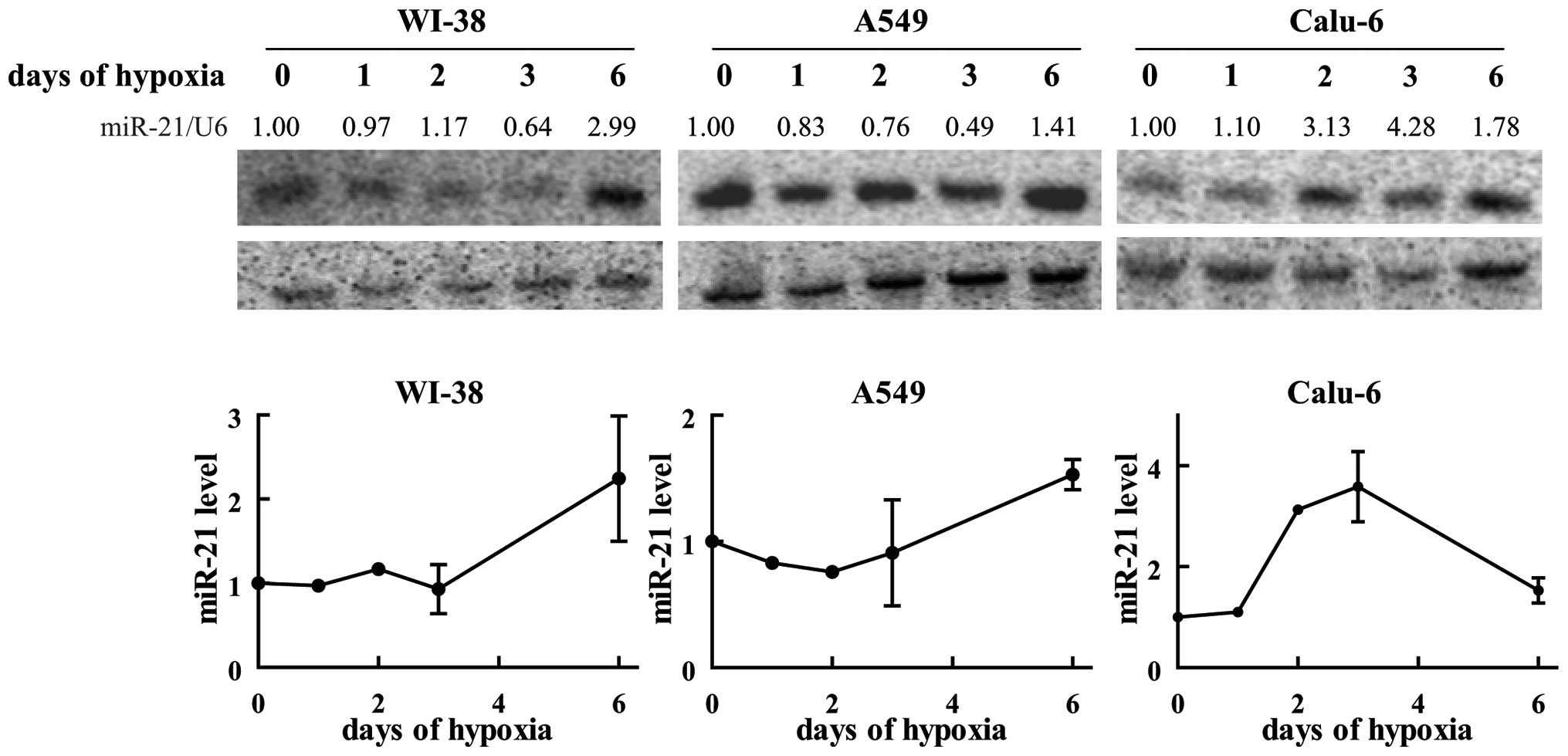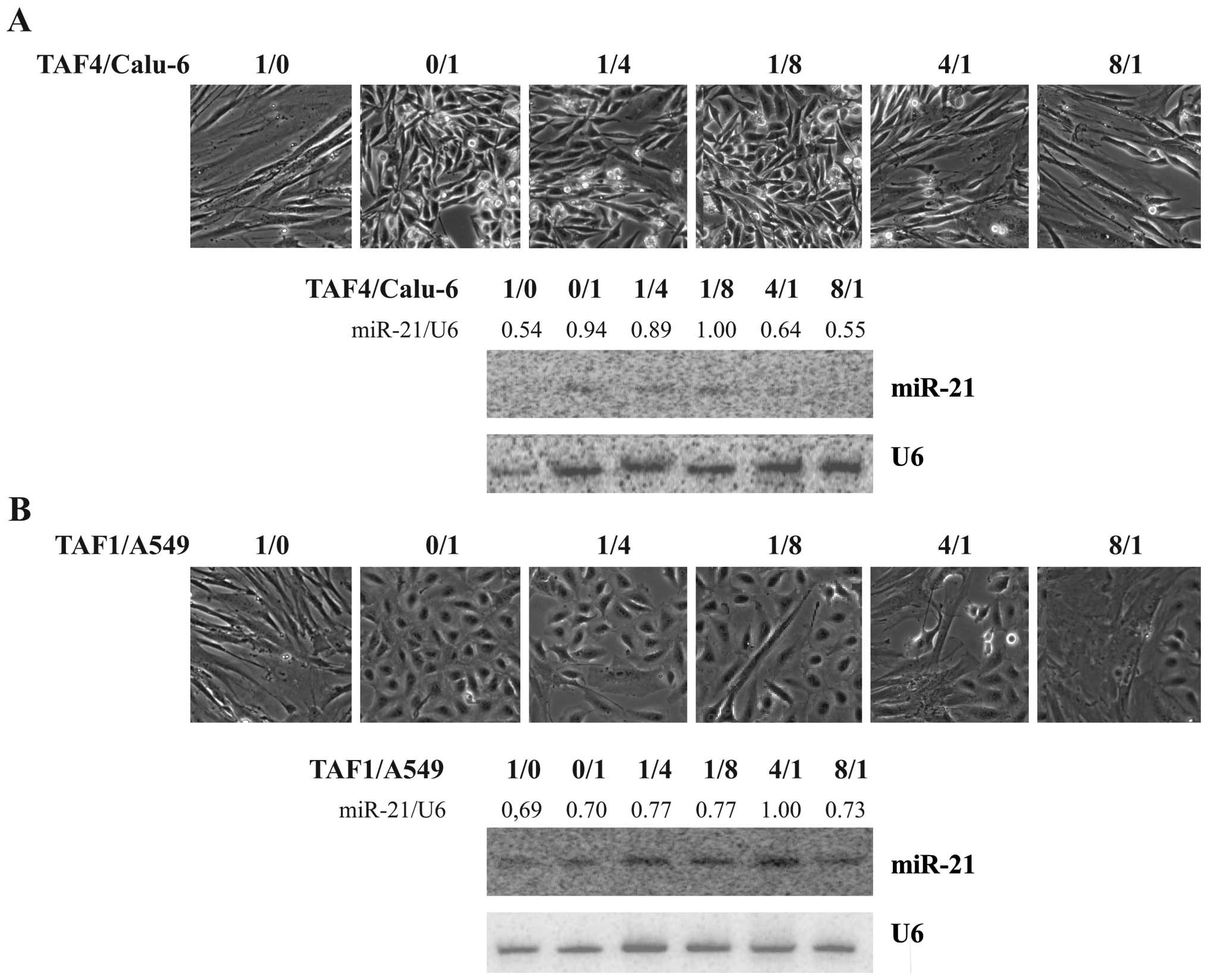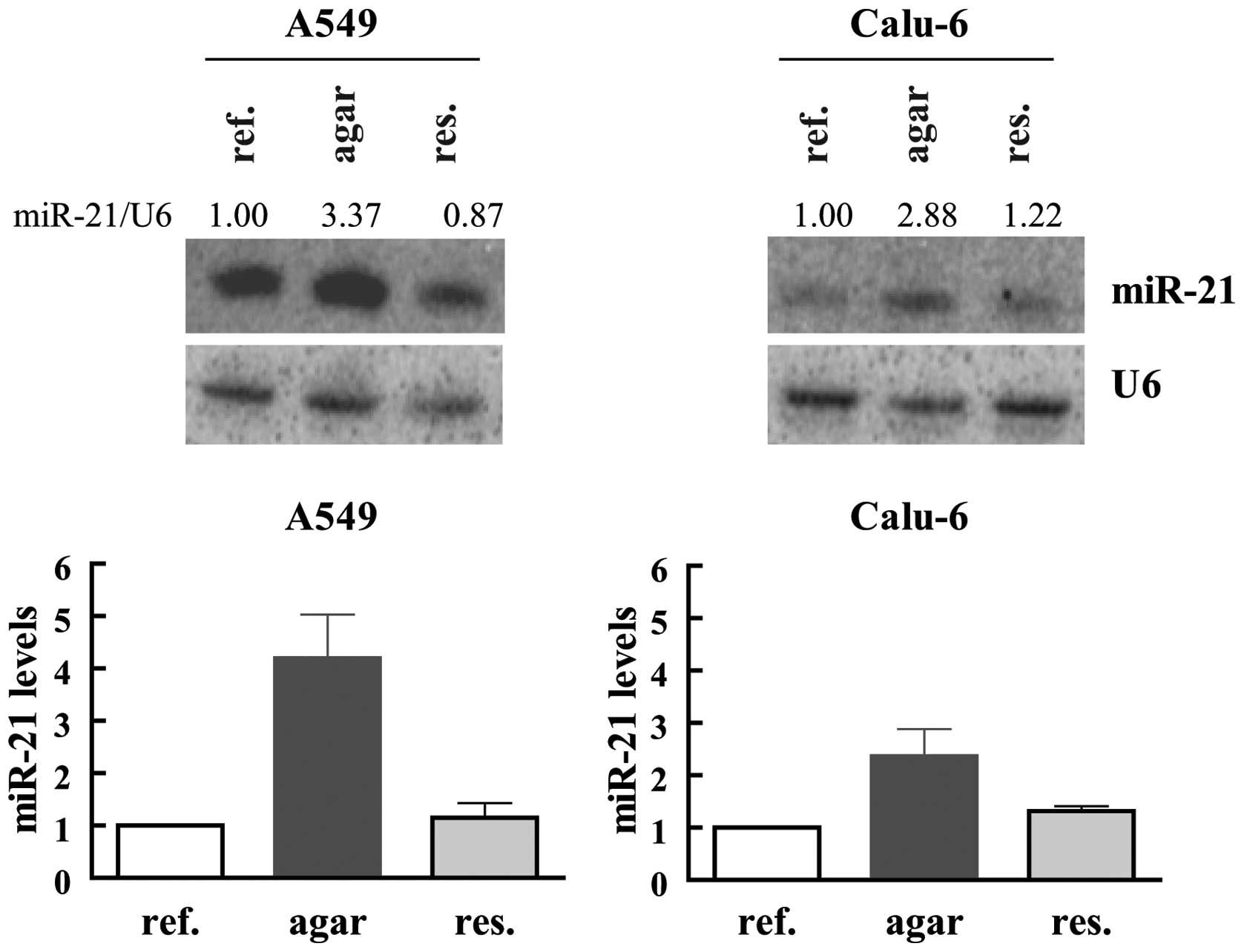Expression of microRNA-21 in non-small cell lung cancer tissue increases with disease progression and is likely caused by growth conditional changes during malignant transformation
- Authors:
- Published online on: January 22, 2014 https://doi.org/10.3892/ijo.2014.2272
- Pages: 1325-1334
Abstract
Introduction
MicroRNAs (miRNAs) are endogenous expressed small non-coding RNAs with important functions in almost all biological processes (1). Usually these miRNAs negatively influence gene expression by destabilizing mRNAs or inhibiting their translation (2). MiRNAs recognize their substrates by binding sequences which are perfectly complementary to the so called seed regions compromising nucleotides 2–8. The targeted regions usually lie in the 3’UTR of the mRNAs and are present in multiple copies (2). A single miRNA can modulate the expression of more than hundred genes.
MiRNAs are processed from long capped and polyadenylated primary transcripts (pri-miRNA) produced by RNA polymerase II. Before exported to the cytoplasma a nuclear processing step synthesizes the ∼70 nucleotides (nt) long precursor miRNA (pre-miR). Further maturation includes cleavage to a duplex of ∼20 nt and loading of one strand to a ribonucleotide protein complex able to function as miRNA-induced silencing complexes (miRISCs) (1,2). Expression patterns of specific miRNAs vary within different cell and tissue types (3). Their expression is often dynamically changing during developmental processes and in diseases (1). Characterization of miRNA expressions indicates that several miRNAs may have a crucial role in cancer progression of various tumors. They can function as tumor-suppressors or as oncogenes (termed oncomirs) (4).
MiRNA signature in different cancers identified microRNA-21 (miR-21) as one of the most abundant oncomirs (5). Elevated miR-21 expression in cancer cells compared to the normal control cells were observed in almost all solid tumors (6) including head and neck (7), colorectal (8,9), lung (6,10), breast (11,12), esophageal (13) and liver cancer (14).
Consistent with a postulated function as an oncomir, miR-21 targets mRNAs coding for proteins with functions as inhibitor of cell signaling such as phosphatase and tensin homolog (PTEN) tumor suppressor (14), Sprouty1 (Spry1) (15) or Sprouty2 (Spry2) (16) or of cell cycle progression like cell division cycle 25 homolog A (CDC25A) (17) as well as genes involved in regulation of cell death like programmed cell death 4 (PDCD4) (18,19).
In this investigation we analyzed the expression of miR-21 in 36 NSCLC-derived tumor tissue and 14 cell lines and compared it to the expression in normal lung tissue. We further analyzed if elevated miR-21 expression in the malignant tissue is influenced by environmental growth conditions.
Materials and methods
Patients
Tumor and normal lung tissue samples were derived from patients with histological confirmed NSCLC who underwent surgical resection at the Otto Wagner Hospital. At the time of surgery the patients had not undergone chemotherapy. Only tissues with a macroscopic visible tumor were chosen. All tumors were histologically confirmed. The normal tissue samples were taken from the surrounding normal tissue. The distance between the normal tissue to the tumor was ≥2 cm. If the interspace between the tumor and the normal lung tissue specimens was >5 cm, the normal sample was classified as distal, if the distance to the tumor was <5 cm it was characterized as proximal. All tissue samples were immediately flash frozen in liquid nitrogen and stored at −80°C until use. Information on the pathologic stage of each tumor according to the WHO classifications was available for 33 of 36 patients. Samples were derived from 6 patients staged as IA and 12 as IB. Only two of the tumor samples were obtained from patients classified as stage IIA. Furthermore, samples from 4 IIB-staged and 8 IIIA staged patients were investigated. One of the patients had lung cancer classified as stage IV. Concerning histology, 23 of the tumors were adenocarcinoma and 13 were squamous cell carcinoma. The use of the patient sections for the study was approved by the ethics committee of the City of Vienna (EK 07-176-VK) according to legal Austrian regulations.
Cell culture
Six of the cancer-derived cell lines and the normal embryonic lung fibroblasts WI-38 as well as immortalised bronchial epithelial cells (Beas2B, CRL9606) were purchased from the American Type Culture Collection (ATCC) and cultured in the recommended medium containing 10% fetal bovine serum (FBS) (GE Healthcare, Chalfont St. Giles, Buckinghamshire, UK) and supplemented with penicillin (100 U/ml) and streptomycin (100 μg/ml). Three of these cell lines (A549, A427, SK-LU-1) harbor a K-RasG12 mutation and one (Calu-6) a K-RasQ61 mutation. Two of these NSCLC-derived cell lines (CRL2868 and CRL5883) carry an acquired exon 19 in frame deletion (E746-A750) of EGFR.
Additionally, eight NSCLC cell lines were established at our institute as described (20). These cell lines were cultured using DMEM growth medium (GE Healthcare) containing 10% FBS supplemented with penicillin, streptomycin and pyruvate. Cell lines were authenticated by array-comparative genomic hybridization or DNA fingerprinting and regularly checked for Mycoplasma contamination.
Synchronization of cells in certain phases of the cell cycle was achieved by serum starvation as described (21). Propidium iodide-based DNA content analysis (PI-staining) was performed as described (22). Hypoxic conditions were achieved by incubating the cells in a Heracell 150i incubator (Thermo Scientific, Waltham, MA, USA) at 1% oxygen, 5% CO2 and 37°C. To standardize pH, 25 mM HEPES, pH 8.0 was added to the medium. Anchorage-independent growth was achieved by cultivating the cells in plates coated with 1% noble agar (Sigma-Aldrich, St. Louis, MO, USA).
Isolation of human primary lung fibroblasts and tumor-associated fibroblasts
During lobectomy operations a surgical specimen was obtained directly from the tumor site as well as from a distant tumor-free part of the removed lung lobe. Samples were immediately transferred into the laboratory and washed with DMEM containing antibiotic and anti-mycotic solution (penicillin, streptomycin and amphotericin B, Sigma-Aldrich). The tissue piece was minced by a scalpel and incubated with trypsin solution (0.25 wt/vol% trypsin in PBS, Sigma). After 30 min at 37°C, the samples were triturated with a pipette while in DMEM with 10% FCS. Following centrifugation the suspension and clumps were plated in a tissue culture flask in DMEM with 10% FCS. Following 48 h of culture the non-adhering connective fiber dense pieces were transferred into a new culture flask. After a few days these clumps adhered and fibroblasts radially migrated out from the tissue pieces. At confluence, the cultures were trypsinized (0.25 wt/vol% trypsin in PBS) and the cells were transferred into tissue-culture flasks containing DMEM with 10% FCS. Following four passages, the lung fibroblasts were frozen in 10% dimethyl sulphoxid-10%FCS-DMEM solution and stored in liquid N2 for later use. Procedures to isolate lung tissue associated fibroblasts were approved by the ethics committee of the Medical University of Vienna (MUW#904-2009).
RNA isolation and northern blotting
RNA isolation was performed as described (23). For the tissue, prior to the isolation procedure samples were cut into small pieces and transferred to homogenization tubes prefilled with lysis buffer plus 5–6 ceramic beads. Homogenization was performed twice at 5500 for 2×20 sec, with 10-sec breaks in a Precellys 24 homogenisator (PEQLAB, Erlangen, Germany).
RNA (10 or 15 μg) was separated by an 18% denaturing polyacrylamide gel electrophoresis containing 7.6 M urea using TBE as running buffer. Prior to loading RNA was mixed with equal volumes of loading buffer (formamide plus 10 mM EDTA pH 8.0 and bromophenol blue) and incubated for 5 min at 70°C. Separated RNA was blotted onto nylon membrane (GeneScreen plus from Perkin-Elmer, Waltham, MA, USA) using 0.5X TBE as buffer in a Bio-Rad transfer apparatus (Bio-Rad, Hercules, CA, USA) at constant 150 mA overnight at 4°C. The transferred RNA was crosslinked to the membrane with UV (Stratalinker; auto-crosslinking: 1200 μJ energy). After methylene blue staining the membrane was stored at −20°C. Hybridisation was performed as described (24). As probes oligo-nucleotides from Microsynth AG (Balgach, Switzerland) were used: miR-21 probe: TCAACATCAGTCTGATAAGCTA; U6 probe [probe for Homo sapiens U6 small nuclear 2 RNA (RNU6-2)]: CACGAATTTGCGTGTCATCCTT; 5SrRNA probe ATT CCCAGGCGGTCTCCCATCC. Probes were labeled by polynucleotide kinase (New England Biolabs, Ipswich, MA, USA) according to the manufacturer’s instructions using 5 μl γ[32P]-ATP (3,000 Ci/mmole) (Hartmann Analytic, Braunschweig, Germany). Washing of the membranes was performed at 50°C in a non-stringent washing buffer (3X SSC, 25 mM sodium phosphate pH 7.5, 5% SDS) and a stringent washing buffer (1X SSC, 1% SDS). Intensity of the signals was detected using a Typhoon phosphorimager (GE Healthcare).
Immunoblotting
Western blotting was performed as described (21). Primary antibodies against β-actin (Novus Biologicals, CO, USA) and Au5 epitope (Bethyl Laboratories, TX, USA) were used.
Results
MiR-21 levels in NSCLC-derived tissue are elevated
As an initial experiment we compared miR-21 levels of normal and tumor tissue from patients with histological confirmed NSCLC. Endogenous miR-21 levels were determined by northern blotting of total RNA isolated from malignant and the corresponding normal tissue sections of the same patient (Fig. 1A). Mature miR-21 was visible in all samples analyzed, while we failed to detect pre-miR-21 RNA in most cases and therefore it was excluded from the analysis. As loading control probes recognizing U6 and 5SrRNA were used. Since in the samples from a few patients the U6 levels were strongly reduced (data not shown), we normalized the detected miR-21 signal to the one obtained for 5SrRNA. For the first analysis, miR-21 levels were calculated in reference to an internal standard value loaded on every northern blot and grouped into malignant tissue and normal samples derived from tissue proximal or distal to the tumor section. As depicted in Fig. 1B, miR-21 levels in normal lung tissue isolated distal to the tumor (n=26) were constantly low and showed little fluctuation. In sections proximal to the tumor (n=21), miR-21 expression was on average increased and showed more variability. In the tumor-derived samples low and high miR-21 expressions were observed, leading to strong variations of miR-21 levels. In the tumor compartments miR-21 levels were on average 4- and 3-fold increased in relation to distal and proximal analyzed tissue, respectively (Fig. 1B). For the consecutive data analysis, each tumor sample was normalized to the value obtained in the unaffected lung tissue of the same patient. In 30 of 36 sample pairs the miR-21 level was increased >2-fold in the tumor-derived RNA in comparison to the one obtained from the corresponding healthy tissue. In only six patients the miR-21 amount in the tumor section was comparable (less than 2-fold changed) to the normal tissue sample. None of the investigated tumor tissues showed lower miR-21 levels in comparison to the normal lung. Compared to the corresponding normal lung tissue, miR-21 elevation varied from 1.4- to 11-fold in the tested patient. In the majority of tumors miR-21 levels were raised >2-fold and in one sixth of the tumors we observed even a 5–10-fold increase of miR-21 levels when compared to the expression levels of the normal lung tissue of the same patient (Fig. 1A, C and D). Concerning histology, in adenocarcinoma miR-21 upregulation was not significantly different from the one calculated for squamous cell carcinoma, although on average adenocarcinoma expressed more miR-21 than squamous cell carcinoma (Fig. 1C). With respect to differentiation, we observed that upregulation of miR-21 in the malignant section was stronger in less differentiated tumors (mean G1=3.1, G2=3.5, G3=4.7), but the differences were not significant (data not shown). Regarding tumor classification according to the TNM system, in higher malignant stages a more pronounced upregulation of miR-21 in the tumor compared to normal tissue was observed (Fig. 1D). Due to the small sample size a correlation between tumor staging and miR-21 increase cannot be calculated, but using a Mann-Whitney U test miR-21 increased significant between tumor stage IA and IIB (U=2, p=0.042) and between IA and IIIA (U=4, p=0.012).
MiR-21 levels in NSCLC-derived cell lines are comparable to those measured in normal lung cells
Next we analyzed miR-21 in 14 NSCLC-derived cell lines by northern blots. As shown in Fig. 2A all cell lines expressed miR-21, but the endogenous levels showed only modest variation. For quantitative analysis one of the RNAs (the one of VL-10) was loaded on all northern blots and used as a reference. When compared to normal cells (WI-38 and Beas2B) miR-21 levels in lung tumor cell lines varied between 0.6- and 1.8-fold indicating that in none of the tested cell lines miR-21 was clearly overexpressed. Oncogenic mutations like an activating mutation of the epidermal growth factor receptor (EGFR) and K-Ras mutation had no obvious influence on miR-21 expression. The two cell lines with the activated EGFR, CRL2868 and CRL5883, expressed ∼1.6- and 0.7-fold of the level measured in normal lung cells, respectively (Fig. 2B). Additionally, the cell lines were grouped into cell lines harboring a K-Ras mutation and cell lines with unaffected K-Ras alleles (20). The cell lines with the mutated K-Ras had on average higher miR-21 levels compared to the cell lines with the wild-type gene (Fig. 2C). However, possibly due to the small sample size the increase failed to be significant. To further evaluate the influence of oncogenic Ras on miR-21 levels, we expressed dominant active versions of H-Ras, K-Ras and N-Ras in WI-38 cells using the adenoviral system (21). As illustrated in Fig. 2D oncogenic Ras had no influence on miR-21 expression, indicating that Ras is not an important determinant of miR-21 expression.
MiR-21 levels are constant throughout the cell cycle
Although the differences of miR-21 within the measured collection of cell lines varied ∼3-fold, in context of the data obtained from the analysis of the tissue sections, it is surprising that none of the cell lines exhibited a >2-fold increase of miR-21 compared to a normal cell line. This difference could be due to the fact that the miRNA levels of logarithmically growing cells were analyzed, whereas the proportion of proliferating cells may differ fundamentally in the tissue samples. In order to investigate if miR-21 levels are dependent on proliferation status, we arrested WI-38 cells by serum starvation for 3 days and induced cell cycle by addition of medium containing 20% serum. At different time-points cell synchrony was monitored and miR-21 levels were determined. Cells were efficiently blocked in G0 phase in serum-free medium, and ∼80% of the cells re-entered the cell cycle after serum addition. Five hours after cell cycle induction, when cells are expected in G1 phase, DNA content did not change, while 24 h after serum release, most of the cells were clearly in S phase (65% of the cells), and 12 h later the majority of cells had passed through DNA replication and accumulated with 4N DNA content, and then again showed a G1 peak, a DNA distribution typically for cells around mitosis (Fig. 3A). At later time-points cells were growing rather asynchronously. Northern blot analysis revealed that miR-21 is constantly expressed throughout the cell cycle (Fig. 3B). These data indicate that the observed differences in the results obtained from tissue and cell line analyses were not due to variations in proliferation status.
MiR-21 levels are increased in NSCLC tissue, but not in tumor-derived cells
To directly compare the miR-21 levels in cell lines with those in tissue, we performed a northern blot loaded with RNA from the tissue samples of a patient together with RNA from two logarithmically growing cell lines. As demonstrated in Fig. 4A, miR-21 expression measured in cell lines is comparable to the one measured in normal tissue. In contrast, miR-21 is strongly induced in the sample derived from the tumor tissue. Therefore, we conclude that the observed miR-21 increase in the tissue is not primarily caused by tumor cell-specific alterations. To investigate if the stromal cells of the tumor rather than the cancer cells are responsible for the increased miR-21 expression, fibroblasts from the tumor and the normal lung section of 4 patients diagnosed with NSCLC were isolated. In none of the 4 patients the miR-21 levels in the tumor-associated fibroblasts (TAFs) were clearly increased compared to the levels measured in the corresponding sample of the fibroblasts isolated from the normal lung tissue of the patient (Fig. 4B). In relation to cultured primary fibroblasts (WI-38) and to one of the high expressing tumor cell line (A549) the fibroblasts show comparable endogenous levels of miR-21 (Fig. 4B) indicating that the high miR-21 expression detected in tumor tissue is not caused by the stromal compartment but instead is due to conditions specific for tumor tissue. These special circumstances are obviously not mimicked by standardized cell culture.
MiR-21 levels are not influenced by co-cultivation of tumor-derived cells with fibroblasts
Recently, cancer is not only seen as a disease of transformed cells but as the consequence of an interaction of the cancer cells with stromal components. Fibroblasts are important components of the tumor micro-environment and paracrine stimulation pathways between cancer cells and the associated fibroblasts are thought to influence gene expression in both cell types (25). To mimic tumor stromal interactions, we co-cultivated TAFs with NSCLC-derived cell lines for 3 days. The two cell lines (A549 and Calu-6) were chosen and seeded as a mixture in varying ratios as demonstrated in Fig. 6. The growth performance of the chosen cells was not strongly influenced by co-cultivation (upper panel of Fig. 5A and B). Endogenous miR-21 level in TAF4 is on average about half of the one detected in Calu-6 cells, and miR-21 expression of the co-culture reflects the level measured in the predominant cell line (lower panel Fig. 5A). Endogenous miR-21 expression in A549 is comparable to the levels detected in TAF1 cells, and co-cultivation had no influence on miR-21 expression (Fig. 5B). These data indicate that the signals secreted by the stromal fibroblasts are not responsible for augmentation of miR-21 expression in cancer cells.
Hypoxic conditions increase miR-21 levels
Low oxygen availability is a characteristic growth condition of many fast growing tumor masses (25). In order to investigate the role of hypoxia on miR-21 expression, WI-38 as well as two NSCLC-derived cell lines (A549 and Calu-6) were incubated for different time periods at low oxygen levels (1%) and the miR-21 levels were compared to the one of cells growing under normoxic conditions. While at earlier time-points hypoxia failed to influence miR-21 expressions, in WI-38 as well as in the cancer cell line A459 miR-21 levels increased ∼1.5-3-fold when cells were incubated for 6 days in low oxygen (Fig. 6). In Calu-6, miR-21 levels increased already after 2 days in hypoxia and reached their peak (a 3–4-fold increase compared to normoxic levels) at day 3, while at day 6 the levels were diminished again (Fig. 6). In contrast to the other two tested cell lines, an obvious fraction of Calu-6 cells was already dying at day 6 (data not shown), indicating that these cells are more sensitive to oxygen deficiency. Therefore, we cannot exclude that the decrease of miR-21 levels after 6 days is connected to cell death induced by the lowered oxygen availability. Nonetheless, these data demonstrate that hypoxic environment is one determinant responsible for the detected increase of miR-21 levels in the tumor tissue.
Anchorage-independent growth causes augmented miR-21 levels
In order to invade adjacent tissues and to disseminate through the body, tumor cells need to acquire the ability to avoid cell detachment-induced apoptosis and to become anchorage-independent (26). To analyze the influence of anchorage-independent growth conditions on miR-21 expression, the tumor cells were transferred into agar coated plates preventing cellular attachment to the plate. While most of the Calu-6 cells formed clearly visible multicellular spheroids after 5 days of cultivation, in A549 cell line, at this time only few growing spheroid–like structures were visible. Anchorage-independent growing spheroids of Calu-6 and A549 were further cultivated for 1 and 3 weeks, respectively, before RNA was isolated. In both cases miR-21 was clearly increased when cells were forced to detach (Fig. 7). The increase was much more pronounced in the A549 cells (∼3–5-fold) as compared to Calu-6 cells (∼2–3-fold). Although at the time when cells were harvested both cell lines formed nicely growing spheres without visible single cells, it is possible that the difference in the amplitude of miR-21 increase is caused by a stronger selection of especially high miR-21 expressing A549 cells during the longer adaption process to anchorage-independent growth. To test this hypothesis, spheroids were re-seeded and cultivated to monolayers before cells were harvested. In both cell lines miR-21 was downregulated to the levels detected in logarithmically growing cells (Fig. 7). These data show that anchorage-independent growth conditions result in a distinct and reversible increase of miR-21 expression.
Discussion
MicroRNAs are important regulators of gene expression. Since one miRNA can target hundreds of mRNAs, changing its abundance can have an important influence in reprogramming expression systems and adapting to new circumstances. Therefore miRNAs have important functions in many cellular processes as well as in development and diseases including cancer. One of the miRNAs frequently found to be deregulated in malignant tissue is miR-21.
In line with previous reports (27,28), we demonstrated that in lung tissues derived from patients with NSCLC, miR-21 is significantly increased in the tumor tissue when compared with non-malignant lung samples. While in these earlier studies in a huge percentage of samples miR-21 was undetectable, in our study miR-21 was clearly detectable in all patients and variations in the normal lung tissue were minimal. In most of the tumor sections miR-21 levels were clearly increased and the extent of miR-21 elevation increased with malignancy. Tumors staged as IIB and IIIA showed significantly higher miR-21 expression than tumors staged as IA. Possibly due to the differences in detection, the former studies found no connection between staging and miR-21 levels (27,28). In accordance with the earlier investigations (28), we observed a tendency of higher miR-21 amounts in adenocarcinoma compared to squamous cell carcinoma, although the difference was not significant.
In contrast to the observations in the tissue analysis, none of the analyzed NSCLC-derived cell lines (n=14) expressed clearly elevated miR-21 level compared to normal lung derived cells. This discrepancy cannot be explained by a possible difference in the proliferating status of the cells within the tissue sample and cell culture, since our data demonstrate that miR-21 levels do not fluctuate throughout the cell cycle. Earlier reports described that EGFR (29) and K-Ras mutations (30,31) can influence miR-21 levels in lung cancer-derived tissue. Our cell line panel included also cell lines harboring activating mutations in K-Ras or EGFR, but both mutations failed to influence miR-21 levels. This can be due the fact that our sample size is not representative, but it is possible that tumor tissue specific factors are necessary for miR-21 elevation.
In line with this assumption, we observed that all investigated tumor-derived cells cultured under standardized conditions express levels of miR-21 comparable to the one measured in normal lung tissue-derived samples, while the majority of tissue samples clearly increased miR-21 expression levels. Additional to the cancer cells, isolated tumor-associated fibroblasts from lung cancer patients were investigated and also these cells express low levels of miR-21 comparable to the one isolated from the normal lung tissue. This is in agreement with reported in situ hybridization studies demonstrating that in lung cancer tissue miR-21 is predominantly expressed in the cancer cells (32).
Our data demonstrating that tumor-derived cell lines cultured under standardized conditions fail to overexpress miR-21 could explain why in colon cancer two studies in cell lines found that the tumor/normal ratio of miR-21 is negative (33) or low (34), while in contrast reports analyzing miR-21 in colorectal cancer tissue showed that miR-21 levels are significantly increased in the tumor (8,9). Therefore, we conclude that the tissue-specific tumor environment might be necessary for miR-21 elevation.
Although the reprogrammed tumor-associated fibroblasts are expressing low miR-21 amounts, we cannot exclude that miR-21 levels in the cancer cells may be influenced by the tumor-adapted fibroblasts via released factors different from the one secreted by normal lung fibroblasts (35). In our experimental set-up co-cultivation with fibroblasts fails to influence miR-21 expression, and thereby fail to support the hypothesis that in cancer cells paracrine signals from the stromal compartment are responsible for the miR-21 increase.
Apart from the interplay between the cancer cells and the associated fibroblasts, low oxygen levels is a characteristic microenviromental feature especially of larger tumors. Hypoxic conditions induced miR-21 levels in all tested lung cell lines. Corroborating, analysis of colon (36) and breast cell lines revealed that miR-21 is also induced in these tissues although with other kinetics (37). Elevated miR-21 in response to lowered oxygen level was shown to target CDC25A and thereby interferes with cell proliferation (36). Additionally it was shown that miR-21 elevation positively influences VEGF expression. A function in facilitating angiogenesis could be another role of miR-21 (38).
Furthermore we demonstrated that miR-21 levels are elevated when cells lose their usual extracellular matrix and are forced to grow anchorage-independent in spheres. In line with our data it is reported that ectopic miR-21 expression facilitates sphere and tumor formation in SCID mice (39). Corroborating, blocking of miR-21 activity interferes with the metastatic behavior of melanoma cells (40) and breast cells (41). Identified targets, which would explain an important role of miR-21 in invasion and metastasis, are Tropomyosin (42), Reck and TIMP3 (43). Since in our studies miR-21 elevation in spheres was a reversible process we can not substantiate earlier studies showing that cancer stem cells selected as consequence of chemo-resistance exhibit strongly upregulated miR-21 levels (39).
In conclusion, our data show that in lung cancer miR-21 is enriched especially in higher graded tumors and suggest that this upregulation is an adaption of the cancer cells to the tumor-specific environment.
Acknowledgements
We thank Andreas Baierl for helpful support in statistical questions. Furthermore we are thankful to Daniel Drev for skilful technical assistance, and Rosana Kral, Christoph-Erik Mayer and Florian Jantscher for supporting tissue sample collection. This study was supported by Jubiläumsfonds der Österreichischen Nationalbank No. 13720 and by Herzfelder’sche Familienstiftung 09.
References
|
Kloosterman WP and Plasterk RH: The diverse functions of microRNAs in animal development and disease. Dev Cell. 11:441–450. 2006. View Article : Google Scholar : PubMed/NCBI | |
|
Filipowicz W, Bhattacharyya SN and Sonenberg N: Mechanisms of post-transcriptional regulation by microRNAs: are the answers in sight? Nat Rev Genet. 9:102–114. 2008. View Article : Google Scholar : PubMed/NCBI | |
|
Landgraf P, Rusu M, Sheridan R, et al: A mammalian microRNA expression atlas based on small RNA library sequencing. Cell. 129:1401–1414. 2007. View Article : Google Scholar : PubMed/NCBI | |
|
Esquela-Kerscher A and Slack FJ: Oncomirs - microRNAs with a role in cancer. Nat Rev Cancer. 6:259–269. 2006. View Article : Google Scholar | |
|
Jazbutyte V and Thum T: MicroRNA-21: from cancer to cardiovascular disease. Curr Drug Targets. 11:926–935. 2010. View Article : Google Scholar : PubMed/NCBI | |
|
Volinia S, Calin GA, Liu CG, et al: A microRNA expression signature of human solid tumors defines cancer gene targets. Proc Natl Acad Sci USA. 103:2257–2261. 2006. View Article : Google Scholar : PubMed/NCBI | |
|
Avissar M, McClean MD, Kelsey KT and Marsit CJ: MicroRNA expression in head and neck cancer associates with alcohol consumption and survival. Carcinogenesis. 30:2059–2063. 2009. View Article : Google Scholar : PubMed/NCBI | |
|
Slaby O, Svoboda M, Fabian P, et al: Altered expression of miR-21, miR-31, miR-143 and miR-145 is related to clinicopathologic features of colorectal cancer. Oncology. 72:397–402. 2007. View Article : Google Scholar : PubMed/NCBI | |
|
Yamamichi N, Shimomura R, Inada K, et al: Locked nucleic acid in situ hybridization analysis of miR-21 expression during colorectal cancer development. Clin Cancer Res. 15:4009–4016. 2009. View Article : Google Scholar : PubMed/NCBI | |
|
Yanaihara N, Caplen N, Bowman E, et al: Unique microRNA molecular profiles in lung cancer diagnosis and prognosis. Cancer Cell. 9:189–198. 2006. View Article : Google Scholar : PubMed/NCBI | |
|
Iorio MV, Ferracin M, Liu CG, et al: MicroRNA gene expression deregulation in human breast cancer. Cancer Res. 65:7065–7070. 2005. View Article : Google Scholar : PubMed/NCBI | |
|
Yan LX, Huang XF, Shao Q, et al: MicroRNA miR-21 overexpression in human breast cancer is associated with advanced clinical stage, lymph node metastasis and patient poor prognosis. RNA. 14:2348–2360. 2008. View Article : Google Scholar : PubMed/NCBI | |
|
Feber A, Xi L, Luketich JD, et al: MicroRNA expression profiles of esophageal cancer. J Thorac Cardiovasc Surg. 135:255–260. 2008. View Article : Google Scholar | |
|
Meng F, Henson R, Wehbe-Janek H, Ghoshal K, Jacob ST and Patel T: MicroRNA-21 regulates expression of the PTEN tumor suppressor gene in human hepatocellular cancer. Gastroenterology. 133:647–658. 2007. View Article : Google Scholar : PubMed/NCBI | |
|
Thum T, Gross C, Fiedler J, et al: MicroRNA-21 contributes to myocardial disease by stimulating MAP kinase signalling in fibroblasts. Nature. 456:980–984. 2008. View Article : Google Scholar : PubMed/NCBI | |
|
Sayed D, Rane S, Lypowy J, et al: MicroRNA-21 targets Sprouty2 and promotes cellular outgrowths. Mol Biol Cell. 19:3272–3282. 2008. View Article : Google Scholar : PubMed/NCBI | |
|
Wang P, Zou F, Zhang X, et al: microRNA-21 negatively regulates Cdc25A and cell cycle progression in colon cancer cells. Cancer Res. 69:8157–8165. 2009. View Article : Google Scholar : PubMed/NCBI | |
|
Frankel LB, Christoffersen NR, Jacobsen A, Lindow M, Krogh A and Lund AH: Programmed cell death 4 (PDCD4) is an important functional target of the microRNA miR-21 in breast cancer cells. J Biol Chem. 283:1026–1033. 2008. View Article : Google Scholar : PubMed/NCBI | |
|
Asangani IA, Rasheed SA, Nikolova DA, et al: MicroRNA-21 (miR-21) post-transcriptionally downregulates tumor suppressor Pdcd4 and stimulates invasion, intravasation and metastasis in colorectal cancer. Oncogene. 27:2128–2136. 2008. View Article : Google Scholar : PubMed/NCBI | |
|
Sutterluty H, Mayer CE, Setinek U, et al: Down-regulation of Sprouty2 in non-small cell lung cancer contributes to tumor malignancy via extracellular signal-regulated kinase pathway-dependent and -independent mechanisms. Mol Cancer Res. 5:509–520. 2007. View Article : Google Scholar | |
|
Mayer CE, Haigl B, Jantscher F, et al: Bimodal expression of Sprouty2 during the cell cycle is mediated by phase-specific Ras/MAPK and c-Cbl activities. Cell Mol Life Sci. 67:3299–3311. 2010. View Article : Google Scholar : PubMed/NCBI | |
|
Jantscher F, Pirker C, Mayer CE, Berger W and Sutterluety H: Overexpression of Aurora-A in primary cells interferes with S-phase entry by diminishing Cyclin D1 dependent activities. Mol Cancer. 10:282011. View Article : Google Scholar : PubMed/NCBI | |
|
Haigl B, Mayer CE, Siegwart G and Sutterluty H: Sprouty4 levels are increased under hypoxic conditions by enhanced mRNA stability and transcription. Biol Chem. 391:813–821. 2010. View Article : Google Scholar : PubMed/NCBI | |
|
Sutterluety H, Bartl S, Doetzlhofer A, Khier H, Wintersberger E and Seiser C: Growth-regulated antisense transcription of the mouse thymidine kinase gene. Nucleic Acids Res. 26:4989–4995. 1998. View Article : Google Scholar : PubMed/NCBI | |
|
Hanahan D and Weinberg RA: Hallmarks of cancer: the next generation. Cell. 144:646–674. 2011. View Article : Google Scholar : PubMed/NCBI | |
|
Taddei ML, Giannoni E, Fiaschi T and Chiarugi P: Anoikis: an emerging hallmark in health and diseases. J Pathol. 226:380–393. 2012. View Article : Google Scholar : PubMed/NCBI | |
|
Markou A, Tsaroucha EG, Kaklamanis L, Fotinou M, Georgoulias V and Lianidou ES: Prognostic value of mature microRNA-21 and microRNA-205 overexpression in non-small cell lung cancer by quantitative real-time RT-PCR. Clin Chem. 54:1696–1704. 2008. View Article : Google Scholar : PubMed/NCBI | |
|
Voortman J, Goto A, Mendiboure J, et al: MicroRNA expression and clinical outcomes in patients treated with adjuvant chemotherapy after complete resection of non-small cell lung carcinoma. Cancer Res. 70:8288–8298. 2010. View Article : Google Scholar : PubMed/NCBI | |
|
Seike M, Goto A, Okano T, et al: MiR-21 is an EGFR-regulated anti-apoptotic factor in lung cancer in never-smokers. Proc Natl Acad Sci USA. 106:12085–12090. 2009. View Article : Google Scholar : PubMed/NCBI | |
|
Frezzetti D, De Menna M, Zoppoli P, et al: Upregulation of miR-21 by Ras in vivo and its role in tumor growth. Oncogene. 30:275–286. 2011. View Article : Google Scholar : PubMed/NCBI | |
|
Hatley ME, Patrick DM, Garcia MR, et al: Modulation of K-Ras-dependent lung tumorigenesis by MicroRNA-21. Cancer Cell. 18:282–293. 2010. View Article : Google Scholar : PubMed/NCBI | |
|
Sempere LF, Preis M, Yezefski T, et al: Fluorescence-based codetection with protein markers reveals distinct cellular compartments for altered MicroRNA expression in solid tumors. Clin Cancer Res. 16:4246–4255. 2010. View Article : Google Scholar | |
|
Gaur A, Jewell DA, Liang Y, et al: Characterization of microRNA expression levels and their biological correlates in human cancer cell lines. Cancer Res. 67:2456–2468. 2007. View Article : Google Scholar : PubMed/NCBI | |
|
Bandres E, Cubedo E, Agirre X, et al: Identification by real-time PCR of 13 mature microRNAs differentially expressed in colorectal cancer and non-tumoral tissues. Mol Cancer. 5:292006. View Article : Google Scholar | |
|
Bremnes RM, Donnem T, Al-Saad S, et al: The role of tumor stroma in cancer progression and prognosis: emphasis on carcinoma-associated fibroblasts and non-small cell lung cancer. J Thorac Oncol. 6:209–217. 2011. View Article : Google Scholar : PubMed/NCBI | |
|
de Oliveira PE, Zhang L, Wang Z and Lazo JS: Hypoxia-mediated regulation of Cdc25A phosphatase by p21 and miR-21. Cell Cycle. 8:3157–3164. 2009.PubMed/NCBI | |
|
Kulshreshtha R, Ferracin M, Wojcik SE, et al: A microRNA signature of hypoxia. Mol Cell Biol. 27:1859–1867. 2007. View Article : Google Scholar | |
|
Liu LZ, Li C, Chen Q, et al: MiR-21 induced angiogenesis through AKT and ERK activation and HIF-1alpha expression. PLoS One. 6:e191392011. View Article : Google Scholar : PubMed/NCBI | |
|
Yu Y, Kanwar SS, Patel BB, et al: MicroRNA-21 induces stemness by downregulating transforming growth factor beta receptor 2 (TGFbetaR2) in colon cancer cells. Carcinogenesis. 33:68–76. 2012. View Article : Google Scholar : PubMed/NCBI | |
|
Yang CH, Yue J, Pfeffer SR, Handorf CR and Pfeffer LM: MicroRNA miR-21 regulates the metastatic behavior of B16 melanoma cells. J Biol Chem. 286:39172–39178. 2011. View Article : Google Scholar : PubMed/NCBI | |
|
Zhu S, Wu H, Wu F, Nie D, Sheng S and Mo YY: MicroRNA-21 targets tumor suppressor genes in invasion and metastasis. Cell Res. 18:350–359. 2008. View Article : Google Scholar : PubMed/NCBI | |
|
Zhu S, Si ML, Wu H and Mo YY: MicroRNA-21 targets the tumor suppressor gene tropomyosin 1 (TPM1). J Biol Chem. 282:14328–14336. 2007. View Article : Google Scholar : PubMed/NCBI | |
|
Gabriely G, Wurdinger T, Kesari S, et al: MicroRNA 21 promotes glioma invasion by targeting matrix metalloproteinase regulators. Mol Cell Biol. 28:5369–5380. 2008. View Article : Google Scholar : PubMed/NCBI |



